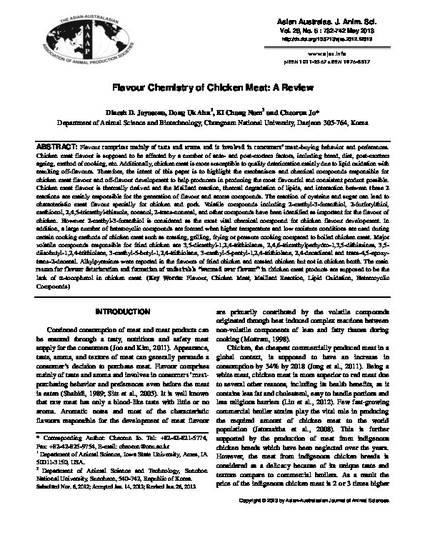
Flavour comprises mainly of taste and aroma and is involved in consumers’ meat-buying behavior and preferences. Chicken meat flavour is supposed to be affected by a number of ante- and post-mortem factors, including breed, diet, post-mortem ageing, method of cooking, etc. Additionally, chicken meat is more susceptible to quality deterioration mainly due to lipid oxidation with resulting off-flavours. Therefore, the intent of this paper is to highlight the mechanisms and chemical compounds responsible for chicken meat flavour and off-flavour development to help producers in producing the most flavourful and consistent product possible. Chicken meat flavour is thermally derived and the Maillard reaction, thermal degradation of lipids, and interaction between these 2 reactions are mainly responsible for the generation of flavour and aroma compounds. The reaction of cysteine and sugar can lead to characteristic meat flavour specially for chicken and pork. Volatile compounds including 2-methyl-3-furanthiol, 2-furfurylthiol, methionol, 2,4,5-trimethyl-thiazole, nonanol, 2-trans-nonenal, and other compounds have been identified as important for the flavour of chicken. However 2-methyl-3-furanthiol is considered as the most vital chemical compound for chicken flavour development. In addition, a large number of heterocyclic compounds are formed when higher temperature and low moisture conditions are used during certain cooking methods of chicken meat such as roasting, grilling, frying or pressure cooking compared to boiled chicken meat. Major volatile compounds responsible for fried chicken are 3,5-dimethyl-1,2,4-trithiolanes, 2,4,6-trimethylperhydro-1,3,5-dithiazines, 3,5-diisobutyl-1,2,4-trithiolane, 3-methyl-5-butyl-1,2,4-trithiolane, 3-methyl-5-pentyl-1,2,4-trithiolane, 2,4-decadienal and trans-4,5-epoxy-trans-2-decenal. Alkylpyrazines were reported in the flavours of fried chicken and roasted chicken but not in chicken broth. The main reason for flavour deterioration and formation of undesirable “warmed over flavour” in chicken meat products are supposed to be the lack of α-tocopherol in chicken meat.
Available at: http://works.bepress.com/dong_ahn/79/

This article is from Asian-Australasian Journal of Animal Sciences 26 (2013): 732, doi:10.5713/ajas.2012.12619. Posted with permission.